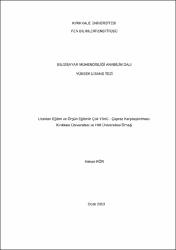Uzaktan eğitim ve örgün eğitimin çok yönlü - çapraz karşılaştırılması: Kırıkkale Üniversitesi ve Hitit Üniversitesi örneği
Özet
Eğitim-öğretim faaliyetleri belirli kanunlar çerçevesinde, devlet kurumları veya özel eğitim kurumları aracılığıyla yürütülmektedir. Bu faaliyetler kendi içerisinde okul öncesi, ilköğretim, ortaöğretim, yükseköğretim gibi birimlere ayrılmaktadır. Belirli bir zaman ve yerde okul niteliği taşıyan kurumlarda önceden belirlenmiş bir plan dâhilinde verilen eğitime örgün eğitim denilmektedir. Bunun dışında belirli bir zaman diliminde akranları ile okula gitme olanağı bulamayan kişilere, istekleri doğrultusunda uzaktan eğitim fırsatı verilmektedir.Uzaktan eğitim; öğretmen ve öğrencinin ayrı mekânlarda, devam zorunluluğu olmadan basılı materyaller, işitsel ve görsel araçlar, video konferans ve internet gibi iletişim araçlarının kullanılması ile yürütülen eğitim-öğretim faaliyetleridir.Gelişen iletişim teknolojileri sayesinde, bilgisayarlara kurulan özel programlar sayesinde dünyanın öbür ucundaki bir kişi ile iletişim kurmak çok kolay hale gelmektedir. İnternet ortamında oluşturulmuş sanal sınıflar, aynı anda yüzlerce kişi alanında kariyer sahibi uzman kişilerden eşzamanlı veya eşzamansız olarak eğitim almasına fırsat sağlamaktadır. Aynı zamanda uzaktan eğitim alan öğrencilerin, başka bir işte çalışarak ekonomik yönden kazanç sağladığı düşünülürse, eğitim veren kurum veya kuruluşlarda, eğitim alan öğrencide eğitim maliyeti yönünden ekonomik kazanç sağlamaktadır.Bu tez çalışmasında, Kırıkkale Üniversitesi ve Hitit Üniversitesi Önlisans programlarında eğitim alan, uzaktan eğitim ve örgün eğitim öğrencileri arasında çok yönlü karşılaştırma yapılmıştır. Belirli kategorilere ayrılmış anket soruları ve sonrasında öntest-sontest soruları öğrencilere web tabanlı olarak uygulanmıştır. Veri tabanına kaydedilen bilgiler veri analiz programı yardımıyla analiz edilerek, uzaktan eğitim ve örgün eğitim karşılaştırma sonuçları elde edilmiştir. Sonuçlar yorumlanmış ve gerekli önerilere sonuç kısmında yer verilmiştir. Education and trainig activities are performed by either government agencies or private schools in accordance with specific regulations. These activities are divided into subcategories such as pre-school, primary education, secondary education and higher education. The education which is carried out at a definite time in the institutions which have the qualities of a school within the framework of a predetermined plan, is called as formal education. Apart from this, people who do not have opportunity to attend the school in a definite period of time with their peers, have distance education opportunity.Distance education is the education and training activity which is carried out with the help of such mass-media equipments as printed materials, audio-visual and video conferencing equipments and internet. With the help of developing communication technology, it is easier than ever to communicate with someone at the far end of the world thanks to the programs installed on personal computers. Virtual classrooms which are created on the internet give chance for hundreds of students to get education synchronously or asynchronously by experts who have career in their own areas. Meanwhile, if it is taken into consideration that the students who attend distance education, may gain income by working in a different occupation, both the institutions that give education and students make a profit in terms of costs of education.In this thesis a versatile comparison has been carried out among the distance and formal education students who receive education in the associate programs of Kırıkkale University and Hitit University. At first, survey questions which are divided into specific categories and then pretest and posttest questions have been given to students as web based. The comparative results between distance and formal education have been obtained by analyzing with the aid of analysis programmes the datas which have been registered into the database. The results have been interpreted and essential suggestions have been given in the conclusion part.
















